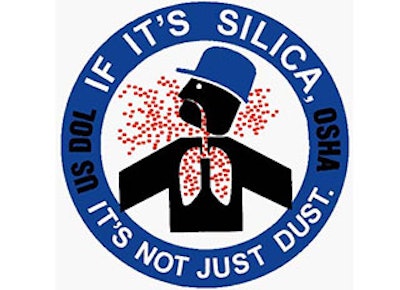
WASHINGTON (AP) — Federal regulators announced plans Friday to dramatically limit workplace exposure to silica dust, an agent known to cause crippling lung disease and cancer in thousands of workers each year.
The proposal from the Occupational Safety and Health Administration would cut in half the amount of silica exposure allowed for general industry and maritime workers. It would slash it by 80 percent for those in the construction industry.
OSHA officials estimated the long-awaited new limits would save nearly 700 lives each year and prevent 1,600 new cases of silicosis annually for those working at construction sites, glass manufacturing plants and other industries.
Workplace safety groups have urged OSHA for years to set new exposure limits, saying they would protect lives. But the proposed new rule is expected to face strong opposition from industry groups that contend lower limits are not necessary and will be too difficult and costly to measure for thousands of businesses.
It's the first major rule proposed under new Labor Secretary Thomas Perez, who was sworn into office last month after a contentious confirmation process. Business groups fiercely opposed him while labor advocates lauded his commitment to safety and workers' rights.
OSHA currently enforces 40-year-old exposure limits for crystalline silica that the agency says are outdated, inconsistent between industries and do not adequately protect worker health.
"We know that disease occurs at exposures below the current standard," said David Michaels, the assistant labor secretary who heads OSHA. "To truly protect the American worker you need to lower the exposure level."
More than 2 million U.S. workers are exposed to silica dust each year, mostly in the construction trades such as jackhammering, cutting, grinding or sawing stone, concrete, bricks and masonry. About 200 workers die annually from silicosis, and as many as 7,300 new cases of silicosis develop each year.
Efforts to set new criteria for silica exposure have been in development for more than 15 years, and the current proposal languished for more than two years as it awaited approval at the White House Office of Management and Budget.
There will be 90 days for the public to submit comments on the rule, followed by public hearings. Michaels said he expected those hearings to last months.
Marc Freedman, executive director of labor law policy at the U.S. Chamber of Commerce, said the new limits on exposure are unnecessary and so low that current equipment cannot measure them accurately. He suggested there should be more focus on addressing the low level of compliance with current limits.
"I don't want this to become all about employers not wanting to spend money on safety, but there will clearly be a cost impact here and there's a question about whether they can even comply," Freedman said.
The current silica exposure limit for general industry and maritime workers is 100 micrograms per cubic meter of air, and 250 micrograms for construction work. OSHA's proposed rule would reduce the limit in all areas to 50 micrograms per cubic meter of air over an eight-hour average.
Freedman warned that, if approved, the plan could be a setback for the hydraulic fracturing industry, a huge but controversial area of growth in domestic energy production that involves pumping huge quantities of water, sand and chemicals at high pressures to break up rock formations to recover oil and gas.
Labor Department spokesman Stephen Barr said the agency has already been working with the fracking industry to voluntarily lower silica exposure levels. Zachary Cikanek, a spokesman for the American Petroleum Institute, said the trade group is still reviewing the proposal.
Michaels said he did not think measuring the lower amounts of silica would pose a problem. But the proposed rule gives construction companies an alternative approach that doesn't require measurement. Instead, those companies can follow alternative dust control methods, such as using mobile vacuum devices that pull dust away from the worker, or attach to a water hose that keeps dust down so it doesn't get into the air during cutting and sawing.
The proposal would delay for two years the requirement that affected businesses use a lab accredited to test for silica exposure. Michaels said that would allow testing procedures to catch up to the new standard.
AFL-CIO President Richard Trumka praised OSHA for proposing the new limits, saying the current OSHA silica standard "was adopted decades ago and fails to protect workers. It allows very high levels of exposure and has no requirements to train workers or monitor exposure levels."
Mark Ellis, president of the National Industrial Sand Association, said he agreed with the proposed plan to mandate dust monitoring and medical surveillance. But he argued there is no need to cut the exposure limit in his industry by half.
"We believe our shared goal of eradicating silicosis from American workplaces can be achieved under the current exposure limit by requiring companies to comply with proposed rules for regular monitoring of the air their workers breathe to insure it is below the current limit," Ellis said.






















